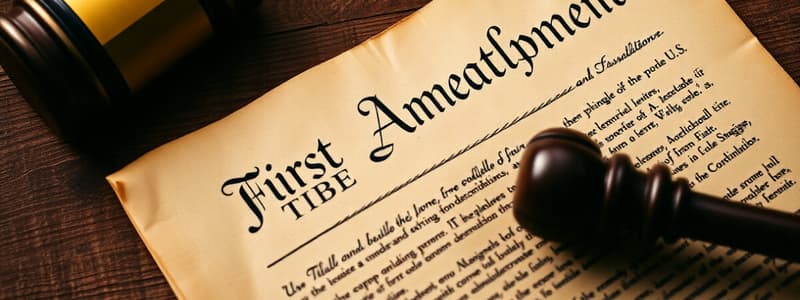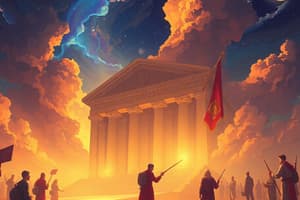Podcast
Questions and Answers
Which of the following rights is NOT explicitly protected by the First Amendment?
Which of the following rights is NOT explicitly protected by the First Amendment?
- Freedom of Speech
- Freedom of the Press
- Freedom of Religion
- Right to Bear Arms (correct)
The Establishment Clause prohibits the government from creating a national religion.
The Establishment Clause prohibits the government from creating a national religion.
True (A)
What landmark Supreme Court case incorporated the Second Amendment's right to bear arms to the states?
What landmark Supreme Court case incorporated the Second Amendment's right to bear arms to the states?
McDonald v. City of Chicago
The ______ rule states that evidence obtained illegally cannot be used in court.
The ______ rule states that evidence obtained illegally cannot be used in court.
What amendment guarantees the right to a speedy and public trial by an impartial jury?
What amendment guarantees the right to a speedy and public trial by an impartial jury?
Match the following amendments with their corresponding rights:
Match the following amendments with their corresponding rights:
The Miranda rights, established in Miranda v. Arizona, protect individuals from being forced to testify against themselves.
The Miranda rights, established in Miranda v. Arizona, protect individuals from being forced to testify against themselves.
What is the main purpose of the Due Process Clause in the 5th and 14th Amendments?
What is the main purpose of the Due Process Clause in the 5th and 14th Amendments?
Which of the following Supreme Court cases established the 'clear and present danger' test for free speech?
Which of the following Supreme Court cases established the 'clear and present danger' test for free speech?
The 14th Amendment's Due Process Clause protects individuals from the actions of state governments.
The 14th Amendment's Due Process Clause protects individuals from the actions of state governments.
What landmark case overturned Plessy v. Ferguson and declared 'separate but equal' unconstitutional in public schools?
What landmark case overturned Plessy v. Ferguson and declared 'separate but equal' unconstitutional in public schools?
The ______ case established judicial review, granting the Supreme Court the power to strike down unconstitutional laws.
The ______ case established judicial review, granting the Supreme Court the power to strike down unconstitutional laws.
Match the landmark Supreme Court cases with their corresponding key principles or impacts:
Match the landmark Supreme Court cases with their corresponding key principles or impacts:
The 'exclusionary rule' was established in the Miranda v. Arizona case.
The 'exclusionary rule' was established in the Miranda v. Arizona case.
What principle allows the Supreme Court to apply the Bill of Rights to state governments through the 14th Amendment's Due Process Clause?
What principle allows the Supreme Court to apply the Bill of Rights to state governments through the 14th Amendment's Due Process Clause?
Which of the following individuals served as the first female Supreme Court Justice?
Which of the following individuals served as the first female Supreme Court Justice?
The ______ Amendment limits excessive bail, fines, and cruel and unusual punishment.
The ______ Amendment limits excessive bail, fines, and cruel and unusual punishment.
The term 'prior restraint' refers to government censorship after publication.
The term 'prior restraint' refers to government censorship after publication.
Flashcards
Gideon v. Wainwright
Gideon v. Wainwright
Established the right to an attorney for defendants in criminal cases.
8th Amendment
8th Amendment
Protects against cruel and unusual punishment and excessive bail.
14th Amendment
14th Amendment
Includes the Equal Protection and Due Process Clauses, extending rights to states.
Clear and Present Danger Test
Clear and Present Danger Test
Signup and view all the flashcards
Symbolic Speech
Symbolic Speech
Signup and view all the flashcards
Prior Restraint
Prior Restraint
Signup and view all the flashcards
Selective Incorporation
Selective Incorporation
Signup and view all the flashcards
Brown v. Board of Education
Brown v. Board of Education
Signup and view all the flashcards
Judicial Review
Judicial Review
Signup and view all the flashcards
Civil Liberties vs. Civil Rights
Civil Liberties vs. Civil Rights
Signup and view all the flashcards
Establishment Clause
Establishment Clause
Signup and view all the flashcards
Free Exercise Clause
Free Exercise Clause
Signup and view all the flashcards
2nd Amendment
2nd Amendment
Signup and view all the flashcards
Exclusionary Rule
Exclusionary Rule
Signup and view all the flashcards
Study Notes
First Amendment Freedoms
- Protects freedom of speech, press, assembly, petition, and religion.
- Freedom of speech is not absolute, with limits on incitement, defamation, and obscenity.
- Freedom of the press is also limited by national security concerns.
- Freedom of assembly allows protests but is subject to time, place, and manner regulations.
- Freedom of religion includes the Establishment Clause (government can't establish a religion) and the Free Exercise Clause (individuals are free to practice).
Second Amendment – Right to Bear Arms
- Debate exists about whether the right is for individual or militias.
- McDonald v. Chicago incorporated the right to state governments.
Fourth Amendment – Search and Seizure
- Requires warrants for searches, except in special circumstances like exigent circumstances, plain view, or automobile exceptions.
- Exclusionary rule (evidence obtained illegally is inadmissible) established in Mapp v. Ohio.
Fifth Amendment – Due Process and Self-Incrimination
- Guarantees due process (fair legal procedures).
- Prevents double jeopardy (being tried twice for the same crime).
- Protects against self-incrimination (Miranda rights).
Sixth Amendment – Right to a Fair Trial
- Guarantees a speedy and public trial by an impartial jury.
- Enshrines the right to an attorney (Gideon v. Wainwright).
Eighth Amendment – Cruel and Unusual Punishment
- Limits excessive bail, fines, and punishments.
Fourteenth Amendment – Equal Protection and Incorporation
- Guarantees due process and equal protection for all.
- The Due Process Clause extends Bill of Rights protections to the states (Selective Incorporation).
- The Equal Protection Clause prevents discrimination by states, underpinning civil rights.
Landmark Supreme Court Cases
- Schenck v. United States (1919): Established the "clear and present danger" test limiting speech during wartime.
- Tinker v. Des Moines (1969): Protected symbolic student speech in schools.
- New York Times Co. v. United States (1971): Ruled prior restraint unconstitutional.
- Engel v. Vitale (1962): Declared mandatory school prayer unconstitutional.
- Wisconsin v. Yoder (1972): Protected Amish children's religious freedom from mandatory education past a certain age.
- McDonald v. Chicago (2010): Incorporated the Second Amendment to the states.
- Brown v. Board of Education (1954): Declared state-sponsored segregation in public schools unconstitutional.
Key Terms
- Selective Incorporation: Applying the Bill of Rights to states.
- Prior Restraint: Censorship before publication.
- Symbolic Speech: Nonverbal expression protected by the First Amendment.
- Judicial Review: The power of courts to determine laws' constitutionality.
- Civil Liberties vs. Civil Rights: Civil liberties protect from government, civil rights ensure equality under the law.
Important Figures
- James Madison (Bill of Rights author).
- Earl Warren (Chief Justice during many civil rights cases).
- Thurgood Marshall (First African American Supreme Court Justice).
- Sandra Day O'Connor (First female Supreme Court Justice).
- Ruth Bader Ginsburg (Notable advocate for gender equality).
Studying That Suits You
Use AI to generate personalized quizzes and flashcards to suit your learning preferences.



